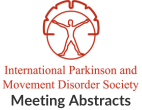Session Information
Date: Thursday, June 23, 2016
Session Title: Dystonia
Session Time: 12:00pm-1:30pm
Location: Exhibit Hall located in Hall B, Level 2
Objective: To investigate if abnormalities observed in the putamen of unaffected first-degree relatives (of cervical dystonia patients) with abnormal temporal discrimination thresholds (TDT) are a downstream effect of abnormal inhibitory activity in the superior colliculus (SC) via the frontal eye fields (FEF).
Background: The TDT is the shortest time interval at which two stimuli are detected to be asynchronous and is a proposed endophenotype of cervical dystonia. Previous imaging work has shown that putaminal enlargement as well as reduced putaminal activation is significantly correlated with TDT abnormalities. It has been hypothesized that the endophenotype, putaminal abnormalities and the disorder are an effect of reduced inhibitory activity in the SC. The current work aims to address this hypothesis.
Methods: fMRI scans were collected during a visual loom/recede paradigm where participants were required to complete a time to contact judgment. Three conditions were included in the experiment; these conditions contained looming, receding or random dot motion and were presented monocularly to increase the perceived effect of movement in space. Data were collected from 23 first-degree relatives (of cervical dystonia patients) with (N = 11) and without (N = 12) abnormal TDTs. A dynamic causal modeling (DCM) analysis was carried out; bilateral SC, fontal eye field and putamen were included in the model.
Results: The winning model suggests that modulation of inhibitory self connects of the SC and connections from the SC to the Frontal Eye Field best explain the observed data. Furthermore a trending correlation of the SC-SC modulations with TDT was observed in all experimental conditions suggesting that inhibitory activity in the SC is larger in participants with longer TDTs.
Conclusions: Under the DCM framework all regions in a model must have an inhibitory self-connection, this biologically plausible condition ensures that the system remains bounded. For the SC, this self-connection can be considered a proxy for GABA activity. Previous work and the current dataset have linked TDT to putaminal abnormalities. Here we have shown that these abnormalities may be a downstream effect of abnormal GABA activity in the SC.
To cite this abstract in AMA style:
B. Quinlivan, R. Moran, E. McGovern, S. Narasimham, I. Beiser, L. Williams, O. Killian, R. Beck, S. O'Riordan, J.S. Butler, M. Hutchinson, R.B. Reilly. A dynamic causal model of the superior colliculus: Inhibitory activity increases with the temporal discrimination threshold [abstract]. Mov Disord. 2016; 31 (suppl 2). https://www.mdsabstracts.org/abstract/a-dynamic-causal-model-of-the-superior-colliculus-inhibitory-activity-increases-with-the-temporal-discrimination-threshold/. Accessed December 1, 2025.« Back to 2016 International Congress
MDS Abstracts - https://www.mdsabstracts.org/abstract/a-dynamic-causal-model-of-the-superior-colliculus-inhibitory-activity-increases-with-the-temporal-discrimination-threshold/
